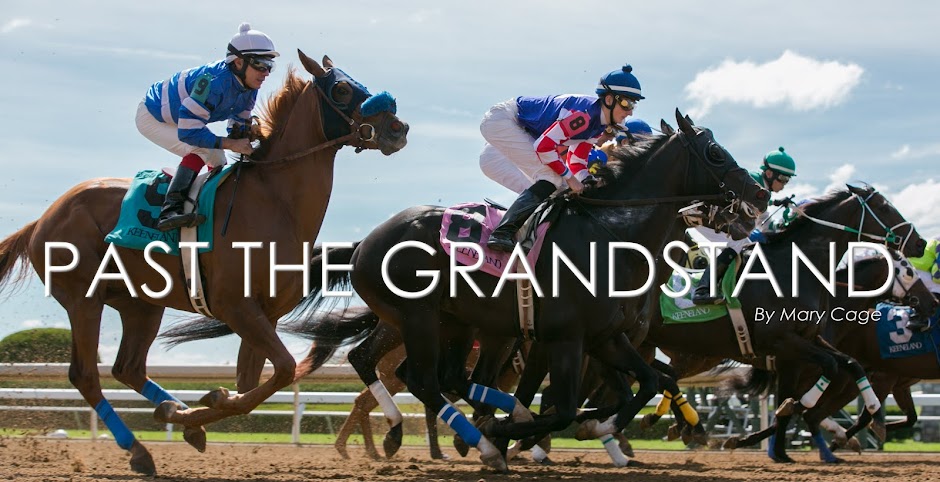The trend for the past several years in racing has been girl power. Racing fans have enjoyed watching Black Caviar, Blind Luck, Goldikova, Havre de Grace, Rags to Riches, Rachel Alexandra, Zenyatta, and many others. It looks as if this trend will continue, as 2011 Horse of the Year Havre de Grace is returning, 2011 Champion Three-Year-Old Filly Royal Delta is preparing for a great year that should include the Dubai World Cup (GI), and 2010 Champion Two-Year-Old Filly Awesome Feather looks to remain perfect after her dominating win in the Florida Sunshine Millions Distaff.
But what about the three-year-old fillies of 2012? Two of the top newly-turned three-year-old fillies – 2011 Champion Two-Year-Old Filly My Miss Aurelia and two-time grade one-winning Weemissfrankie – are out due to injuries. We must turn our attention to other sophomore fillies, including the ones listed below.
Agave Kiss: She has raced solely in New York and only one of her starts has not been against restricted company. However, she has been very dominant. Her first two starts – a state-bred maiden special weight at Belmont and a state-bred allowance at Aqueduct – were won by a combined winning margin of 16 ¾ lengths. Agave Kiss’ initial start against open company came in the Ruthless Stakes at Aqueduct, which she won by 3 ¼ lengths. She is by Lion Heart – winner of the Hollywood Futurity (GI, 8.5F) and the Haskell Invitational Handicap (GI, 9F) and runner-up in the Kentucky Derby (GI, 10F) – and out of the one-mile Delta Princess Stakes winner and Santa Ysabel Stakes (GIII, 8.5) runner-up, Salty Romance. She is inbred 5 X 5 to both Northern Dancer and Raise a Native. Her connections may not plan to run her much outside of New York, but I feel that it would be very exciting to see her race outside of the Big Apple. For more on Agave Kiss, please read my articles here and here.
Applauding: One of the most impressive fillies on this list, Applauding caused jaws to drop when she debuted at Keeneland in October. In that race, she sat off the pace before sweeping to the lead as the field neared the top of the stretch. She never looked back from there, winning the race by 9 lengths in a track record time of 1:07.76 for six furlongs. She made her second start in early December at the Fair Grounds in a six-furlong first-level allowance. After leading from start to finish, Applauding crossed the wire six lengths in front. She was entered in the Silverbulletday Stakes at the Fair Grounds for January 21, but was scratched due to a small bout of colic. By an A.P. Indy son in Congrats and out of a Forestry mare, Applauding definitely has spectacular bloodlines. She is on track for the Fair Grounds Oaks (GII) on March 31.
Broadway’s Alibi: This filly made her first two starts in maiden special weights at Delaware Park, finishing second by a length in her debut before dominating her second start by seven lengths. She did not start for another three months, when she triumphed by five lengths in a six and one-half-furlong allowance optional claiming at Gulfstream Park. She then tried graded stakes company in the seven-furlong Forward Gal Stakes (GII) at Gulfstream on January 29, bounding home to win by an astounding 16 ¾ lengths over a sloppy track. There is doubt in her ability to stretch out, as her sire, Vindication, has primarily been a sire of sprinters and her dam, the graded stakes-winning Strawberry Reason, only won at the distance of a mile and one-sixteenth. Perhaps routing will not be to her liking, but I expect that Broadway’s Alibi will continue to be impressive.
Eden’s Moon: In mid-December, Eden’s Moon made her debut at Hollywood Park, finishing 2 ¼ lengths behind the future Santa Ynez Stakes (GII) winner, Reneesgotzip. She made her first three-year-old start three weeks later, leading from start to finish and winning by an outstanding 11 ½ lengths. By a son of A.P. Indy in Malibu Moon and out of a Giant’s Causeway mare, her pedigree suggests that she will have no trouble with routing. It also helps that her fifth dam – Pange – is a Reine De Course mare who produced the champion Prince Royal II and is the granddam of the ill-fated but great Landaluce. Trainer Bob Baffert scratched her from the Santa Ysabel Stakes (GIII) on January 28.
Grace Hall: Prior to her second-place finish in the Breeders’ Cup Juvenile Fillies (GI), Grace Hall was undefeated. However, being defeated by My Miss Aurelia was not a disgrace. Now that My Miss Aurelia is out, Grace Hall finds herself at the top of many lists as far as sophomore fillies are concerned. After a three-length maiden victory at Delaware Park, she traveled to Saratoga to take the Spinaway Stakes (GI) by nearly two lengths. She then returned to Delaware for her final win of 2011: an effortless victory in the Blue Hen Stakes. Grace Hall is by the Belmont Stakes-winning Empire Maker and out of the Irish-bred stakes-winning mare Season’s Greetings. Tracing back to horses such as Seattle Slew, Riva Ridge, and the Reine De Course mare Comely Nell, it doesn’t seem as if long distances will be a problem for Grace Hall. Trainer Tony Dutrow is preparing her for a start in the Davona Dale Stakes (GII) at Gulfstream on February 25.
Killer Graces: Following a nose defeat in her maiden special weight debut, Killer Graces captured two ungraded stakes at Hollywood Park. After two disappointing finishes in Del Mar graded stakes races, the chestnut filly finished second in a pair of ungraded stakes. She then garnered her first grade one victory in the Hollywood Starlet Stakes (GI), in which her smooth stride carried her to a half-length victory. Her most recent start came on January 28 in the Santa Ysabel Stakes (GIII) and when the winner got an easy lead, it made it difficult for Killer Graces to keep up, which led to her second-place finish. By the multiple grade one-winning Congaree and out of an Old Trieste mare, Killer Graces definitely has plenty of speed and stamina in her pedigree. Trainer Jerry Hollendorfer is preparing her for a start in the Las Virgenes Stakes (GI) at Santa Anita on March 3.
Now I Know: Undefeated in six starts, Now I Know won her first four starts at Remington Park by a combined 17 ½ lengths. One of those wins was a 9 ¼-length victory in the state-bred Oklahoma Classics Lassie Stakes. After that win, she made her first start outside of Oklahoma at Delta Downs in the Delta Downs Princess Stakes (GIII), which she won by 4 lengths. She made her sophomore debut on January 14 in the Dixie Belle Stakes at Oaklawn Park, holding off Amie’s Dini to win by 1 ¼ lengths. By a son of Storm Cat in the 2002 Kentucky Cup Classic Handicap (GII, 9F) winner Pure Prize and out of a Maria’s Mon mare in Now U Know, Now I Know definitely has an impressive pedigree. She is also very impressive on the track and is pointing toward the Martha Washington Stakes – a race that has been won by the likes of Eight Belles and Rachel Alexandra – at Oaklawn Park on February 11 for trainer Donnie K. Von Hemel, who won the race in 2006 with Brownie Points.
Princess Arabella: She has only started once, but she was incredibly impressive in that start. On New Year’s Eve, the Bob Baffert trainee debuted at Santa Anita in a six-furlong maiden special weight. After a poor break from the gate, Princess Arabella gained ground on the leaders with every stride, never decelerating. With a breathtaking move on the outside on the far turn, the chestnut filly swept to the lead with ease under very slight urging from Martin Garcia. By the Haskell winner Any Given Saturday and out of a Thunder Gulch mare, Princess Arabella’s pedigree hints that she will handle a stretch out in distance. She has many tests to pass, but she seems to have the sheer talent and pedigree that will allow her to pass with flying colors.
Reneesgotzip: After soundly defeating Eden’s Moon in her debut, Reneesgotzip tried graded stakes company in her three-year-old debut. On January 15, the chestnut filly dominated the Santa Ynez Stakes (GII) by 7 ¾ lengths, leading from start to finish to defeat five other fillies. She is by City Zip and out of a Distorted Humor mare and is inbred 3 X 4 to Northern Dancer. Trainer Peter Miller is pointing her towards the Las Virgenes Stakes (GI) at Santa Anita on March 3.
Table Three Ten: After her impressive victory in her debut at the Fair Grounds in November, this Cobra Farm-bred filly was purchased by Team Valor. She made her first start for Team Valor and trainer Graham Motion under John Velazquez – the same connections that teamed up to win the 2011 Kentucky Derby – on January 27 in an allowance race at Gulfstream. Sent off as the heavy favorite, she won the six and one-half-furlong race by 1 ¾ lengths. She is by El Prado and out of a stakes-place More Than Ready mare. She traces back to the influential Northern Dancer three times throughout her pedigree and is inbred 5 X 5 to Hail to Reason and 4 X 5 to Special. Her next start is unknown.
Twelve Folds: After two tough losses – one by a nose and one by a head – in her first two starts, Twelve Folds finally got to show the world what she was made of. In a five and one-half California-bred maiden special weight, she won by 8 ¼ lengths. Only one of her starts has been against open company, but she still performed well, finishing second by a head. By a young son of Indian Charlie in Cindago and out of a Tiger Ridge mare, Twelve Folds’ pedigree is not exactly as spectacular as some of the other fillies on this list. However, her fourth dam, Bali Babe, is the dam of 1999 Horse of the Year Charismatic and her sixth dam, Grass Shack, is a Reine De Course mare.
Willa B Awesome: The most heavily raced filly on this list, Willa B Awesome has started ten times. Three of those starts have resulted in victories, two of which were in stakes races. After a win against state-bred maidens in her debut at Hollywood Park, she tried open company in the Cinderella Stakes, finishing third behind the future grade one-winning Killer Graces. Following three unsuccessful stakes tries – two state-bred stakes and one graded stakes – at Del Mar, trainer Walther Solis shipped her to Fairplex Park for the Barrets Debutante Stakes, in which she won by nearly three lengths. After three in-the-money finishes in stakes races – two of which were against California-breds, Willa B Awesome tried graded stakes company in the Santa Ysabel Stakes (GIII) on January 28. She got in easy lead in that race and therefore was able to score by 3 ½ lengths. By a Coronado’s Quest son in Awesome Gambler, most of the appeal in Willa B Awesome’s pedigree is on her sire’s side. However, her fifth dam, Belthazar, is a Reine De Course mare and the final foal sired by the 1937 Triple Crown winner War Admiral. Willa B Awesome will need to continue to prove herself against open company, but she is without a doubt a talented filly.
Remember to like Past the Grandstand on Facebook and follow Past the Grandstand on Twitter! Links can be found on the right side of the blog.
Remember to like Past the Grandstand on Facebook and follow Past the Grandstand on Twitter! Links can be found on the right side of the blog.

















